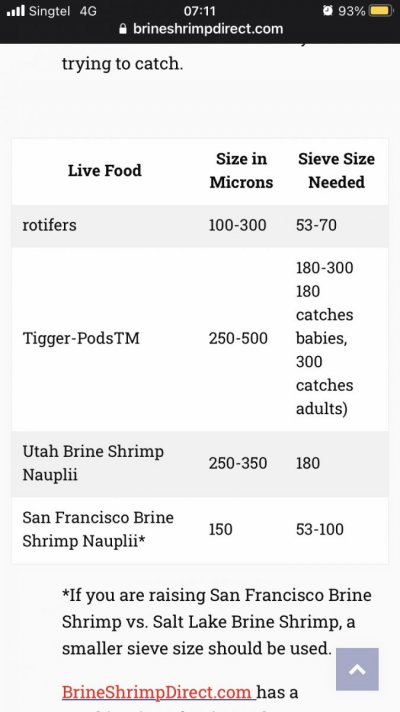Navigation
Install the app
How to install the app on iOS
Follow along with the video below to see how to install our site as a web app on your home screen.
Note: This feature may not be available in some browsers.
More options
You are using an out of date browser. It may not display this or other websites correctly.
You should upgrade or use an alternative browser.
You should upgrade or use an alternative browser.
San Francisco brine shrimp
- Thread starter Leo_ian
- Start date
- Tagged users None
yes that chart is about right ..SFB shrimp are a lil smaller than GSL shrimp ...
still I thought they were 2x bigger than rotifers...
Weird you re having issues with rotifers, heck I quit raising them as they can get everywhere and screw up phyto cultures if not careful
still I thought they were 2x bigger than rotifers...
Weird you re having issues with rotifers, heck I quit raising them as they can get everywhere and screw up phyto cultures if not careful
Mine just constantly crashyes that chart is about right ..SFB shrimp are a lil smaller than GSL shrimp ...
still I thought they were 2x bigger than rotifers...
Weird you re having issues with rotifers, heck I quit raising them as they can get everywhere and screw up phyto cultures if not careful
you using live phyto and splitting the cultures in time?Mine just constantly crash
Heck anyone raising live phyto will tell ya rotifers area pain to control.
FWIW I have reasonable success with tigger pods in BBS tanks
I use bottled phyto but started with live phyto for themyou using live phyto and splitting the cultures in time?
Heck anyone raising live phyto will tell ya rotifers area pain to control.
FWIW I have reasonable success with tigger pods in BBS tanks
- Joined
- Apr 28, 2014
- Messages
- 575
- Reaction score
- 279
They are smaller, but most marine species don’t do particularly well on brine shrimp alone. They lack a lot of essential fatty acids and typically leads to what is known as sudden fright syndrome. They die of shock easily. The typical recommendation is to gut load them to improve the HUFA profile.
Jen over at Colchester Pets was able to raise some peppermint shrimp to adulthood on brine shrimp alone, though the survival rate wasn’t great, but it is an amazing start.
Copepod nauplii and ciliates (and a yet undetermined source that is filling in the gaps) are more nutritious for the larvae. They avoid the explicit need to gut load while providing a better balanced diet. First foods has been the biggest hurdle to being able to successfully breed at home without it being extremely labor and resource intensive seeing as we don’t typically have access to the same resources as the labs just due to differences in scale and how that effects overall cost.
Jen over at Colchester Pets was able to raise some peppermint shrimp to adulthood on brine shrimp alone, though the survival rate wasn’t great, but it is an amazing start.
Copepod nauplii and ciliates (and a yet undetermined source that is filling in the gaps) are more nutritious for the larvae. They avoid the explicit need to gut load while providing a better balanced diet. First foods has been the biggest hurdle to being able to successfully breed at home without it being extremely labor and resource intensive seeing as we don’t typically have access to the same resources as the labs just due to differences in scale and how that effects overall cost.
Yea I will also be feeding parvacalanus copepodsThey are smaller, but most marine species don’t do particularly well on brine shrimp alone. They lack a lot of essential fatty acids and typically leads to what is known as sudden fright syndrome. They die of shock easily. The typical recommendation is to gut load them to improve the HUFA profile.
Jen over at Colchester Pets was able to raise some peppermint shrimp to adulthood on brine shrimp alone, though the survival rate wasn’t great, but it is an amazing start.
Copepod nauplii and ciliates (and a yet undetermined source that is filling in the gaps) are more nutritious for the larvae. They avoid the explicit need to gut load while providing a better balanced diet. First foods has been the biggest hurdle to being able to successfully breed at home without it being extremely labor and resource intensive seeing as we don’t typically have access to the same resources as the labs just due to differences in scale and how that effects overall cost.
why can’t I spell
- Joined
- Apr 28, 2014
- Messages
- 575
- Reaction score
- 279
Awesome!Yea I will also be feeding parvacalanus copepods
why can’t I spell
Parvo seems to be one of the critical species for aquaculture. I keep contemolating artemia as a backup emergency food source. I’d be interested in seeing data on the energy profile and size differences between hatchable decapsulated San Francisco and the standard eggs.
You aren’t far off. The second a is an o (too much time reading and searching for research papers that I don’t have access to. I need this pandemic over so I can get into the university library again). Parvocalanus.
Similar threads
- Replies
- 2
- Views
- 321
- Replies
- 5
- Views
- 278
- Replies
- 1
- Views
- 162
- Replies
- 19
- Views
- 1,279


















